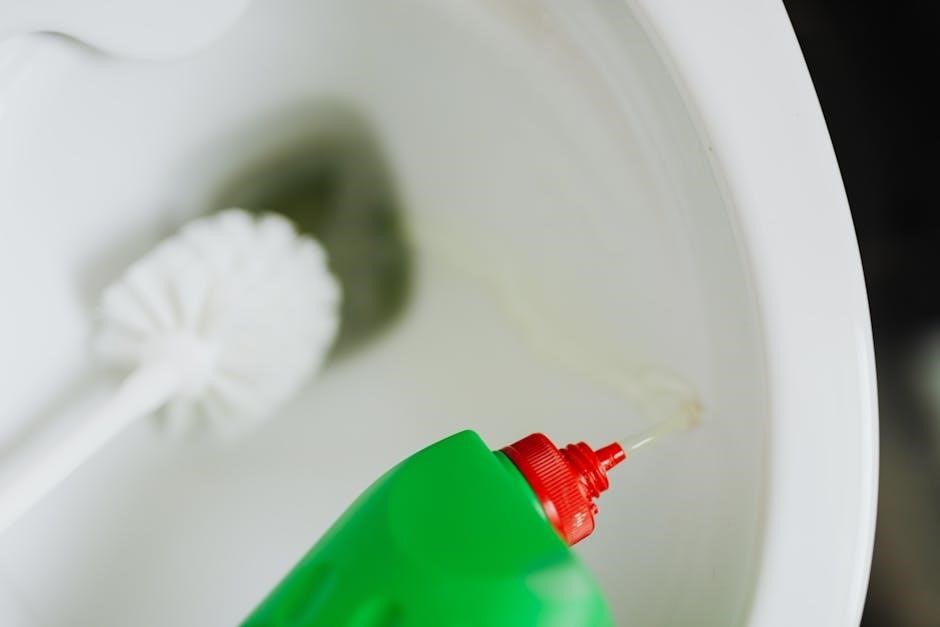Honeywell Home thermostats offer efficient temperature control‚ enhancing comfort and energy savings. Designed with user-friendly interfaces‚ they provide precise heating and cooling management for optimal home environments.
1.1 Overview of Honeywell Home Thermostats
Honeywell Home thermostats are renowned for their innovative design and user-friendly functionality‚ offering precise temperature control and energy efficiency. The T6 model‚ for instance‚ features a sleek white design and smart capabilities‚ while the DT4 model has earned accolades for its quality and design from the Red Dot Design Award. These thermostats are designed to be installed in stable temperature locations‚ away from doors or air vents‚ ensuring accurate performance. With features like remote control through the Honeywell Home app‚ multiple operating modes (Heat‚ Cool‚ Off‚ Auto‚ Em Heat)‚ and advanced fan controls‚ they provide comprehensive climate management. The manuals guide users through installation‚ highlighting the importance of proper setup to avoid damaging the system and ensuring optimal functionality. Honeywell Home thermostats are a blend of innovation‚ reliability‚ and user-centric design‚ making them a popular choice for modern homes.
1.2 Importance of the Manual
The manual is essential for proper installation‚ operation‚ and maintenance of Honeywell Home thermostats. It provides detailed instructions to ensure safe and efficient use‚ preventing potential damage to the system. The guide covers key aspects such as selecting the right location for installation‚ avoiding areas with fluctuating temperatures‚ and understanding the thermostat’s features. It also offers troubleshooting tips and maintenance advice‚ like cleaning the device and replacing batteries. The manual serves as a comprehensive resource to maximize the thermostat’s performance and longevity‚ ensuring users can fully utilize its smart capabilities and energy-saving functions. By following the manual’s guidelines‚ users can optimize their home’s climate control while adhering to safety precautions and best practices recommended by Honeywell.

Installation of Honeywell Home Thermostats
Honeywell Home thermostats require careful installation in areas with stable temperatures‚ away from drafts or vents. The new T6 model offers enhanced features and design improvements.
2.1 Choosing the Right Location
Choosing the right location for your Honeywell Home thermostat is crucial for accurate temperature control. It should be installed in an area with a consistent temperature‚ away from direct sunlight‚ drafts‚ or air vents. Avoid placing it near doors or windows to ensure precise readings. The Honeywell Home T6 model‚ now available in a sleek white design‚ offers advanced features for enhanced comfort. The DT4 model‚ recognized for its design excellence‚ provides reliable performance. Ensure the location is accessible for easy operation and maintenance. Proper placement ensures optimal functionality‚ energy efficiency‚ and comfort. Refer to the manual for specific guidelines to avoid installation errors and maintain warranty validity. Correct positioning is key to maximizing your thermostat’s performance and energy-saving capabilities.
2.2 Step-by-Step Installation Guide
Before starting‚ ensure the power to your HVAC system is turned off. Remove the old thermostat and take note of the wire connections for reference. Install the new Honeywell Home thermostat by connecting the wires to the appropriate terminals‚ ensuring they are securely fastened. Mount the thermostat on the wall at the recommended height‚ typically around 52-60 inches from the floor. Once installed‚ turn the power back on and test the system by switching between modes (Heat‚ Cool‚ Off‚ Auto). Allow 5 minutes for the system to restart safely to avoid damaging the compressor. Refer to the manual for specific instructions tailored to your model‚ such as the TH-400 or T6‚ to ensure proper setup and functionality. Always follow safety precautions and guidelines provided in the manual to avoid installation errors and maintain warranty validity.

Understanding the Thermostat Components
This section describes the essential components of Honeywell Home thermostats‚ including the display screen‚ navigation buttons‚ temperature sensor‚ wire terminals‚ and battery compartment‚ ensuring proper functionality and user interaction.
3.1 Interface and Display Overview
The Honeywell Home thermostat features a user-friendly interface with a high-resolution LCD display. The screen shows current temperature‚ setpoint‚ and system status. The interface includes a touchscreen or button controls‚ depending on the model‚ allowing easy navigation through menus. The display is backlit for better visibility in low-light conditions. Key elements include temperature adjustment arrows‚ mode selection buttons‚ and indicators for heating‚ cooling‚ or fan operation. The interface also provides prompts for programming schedules and accessing advanced settings. Some models offer a lockscreen feature to prevent unauthorized changes. The intuitive design ensures seamless interaction‚ making it easy to monitor and adjust settings efficiently. This overview highlights the essential visual and interactive components that enhance user experience.
3.2 Key Features and Controls
Honeywell Home thermostats are equipped with a range of intuitive controls and advanced features. The touchscreen interface allows users to easily adjust temperature settings‚ access menus‚ and view system status. Key controls include temperature adjustment buttons‚ mode selection‚ and fan operation switches. Programmable scheduling enables users to set custom temperature profiles for energy efficiency. Geofencing and smart alerts provide location-based temperature control and notifications for system events. Energy usage reports help users monitor and optimize their consumption. Vacation mode ensures energy savings while away. These thermostats also support integration with smart home systems and voice assistants like Alexa and Google Assistant. The controls are designed for simplicity‚ offering both manual overrides and automated functions to meet diverse user needs. This combination of features enhances comfort‚ convenience‚ and energy efficiency.

Operating Modes of Honeywell Home Thermostats
Honeywell Home thermostats offer Heat‚ Cool‚ Off‚ and Auto modes‚ ensuring precise temperature control and energy efficiency while integrating seamlessly with smart home systems for enhanced functionality;
4.1 Heat Mode
The Heat mode on Honeywell Home thermostats activates the heating system to maintain a set temperature during colder periods. This mode ensures your space stays warm by automatically turning on the heater when the room temperature drops below the desired level. Users can adjust the temperature setpoint using the interface‚ and the thermostat will regulate the heating system to achieve and maintain the selected temperature. Heat mode is ideal for winter settings and provides consistent comfort. It also works efficiently with various heating systems‚ including furnaces and heat pumps. For optimal performance‚ ensure the thermostat is correctly configured and the heating system is functioning properly. Adjusting the setpoint slightly can help balance comfort and energy savings.
4.2 Cool Mode
The Cool mode on Honeywell Home thermostats engages the cooling system to maintain a desired temperature during warmer periods. This mode ensures your space stays cool by automatically activating the air conditioning or cooling system when the room temperature rises above the setpoint. Users can easily adjust the temperature using the thermostat’s interface‚ and the system will regulate cooling to maintain comfort. Cool mode is essential for summer settings and provides consistent temperature control; It is compatible with various cooling systems‚ including central air conditioning and heat pumps. For energy efficiency‚ slightly raising the setpoint can help reduce energy consumption while still keeping your space comfortable. Proper configuration and system maintenance are key to optimal performance in Cool mode.
4.3 Off Mode
The Off mode on Honeywell Home thermostats deactivates both heating and cooling systems‚ stopping any temperature regulation. This mode is ideal when no climate control is needed‚ such as during extended absences or mild weather. When in Off mode‚ the thermostat will not trigger the HVAC system‚ helping to conserve energy. However‚ the thermostat remains powered on to display the current temperature and maintain settings. Off mode is useful for periods when external conditions are comfortable‚ or when alternative heating/cooling methods are in use. It allows users to pause their HVAC system without losing their programmed settings. This mode is energy-efficient and provides flexibility for users to manage their comfort needs effectively. Always ensure the system is in Off mode during maintenance or repairs to avoid unexpected operation.
4.4 Auto Mode
The Auto mode on Honeywell Home thermostats allows the system to automatically switch between heating and cooling to maintain the desired temperature. This mode is ideal for maintaining consistent comfort levels without manual intervention. When enabled‚ the thermostat compares the current room temperature to the setpoint and activates either heating or cooling as needed. Auto mode is energy-efficient‚ as it avoids unnecessary operation by only engaging the system when temperature adjustments are required. Users can set a single temperature‚ and the thermostat handles the rest‚ ensuring optimal comfort and energy savings. This mode is particularly useful for maintaining a steady temperature throughout the day‚ especially in climates with fluctuating conditions. It minimizes the need for frequent manual adjustments‚ providing a hassle-free experience for homeowners.

Programming and Scheduling
Programming and scheduling on Honeywell Home thermostats enable users to set custom temperature schedules for optimal comfort and energy efficiency‚ adapting to daily routines seamlessly.
5.1 Manual vs. Automatic Mode
The Honeywell Home thermostat offers two primary operating modes: Manual and Automatic. In Manual Mode‚ users can set a constant temperature that remains unchanged until manually adjusted. This mode is ideal for individuals who prefer consistent temperatures without scheduling. On the other hand‚ Automatic Mode allows users to create and follow a programmed schedule‚ adjusting temperatures based on daily routines to optimize energy usage.
Automatic Mode is particularly useful for homeowners who want to save energy by lowering or raising temperatures during periods when the home is unoccupied or when family members are asleep. Switching between these modes is straightforward‚ providing flexibility to suit different lifestyles and preferences.
5.2 Creating a Daily Schedule
Creating a daily schedule on your Honeywell Home thermostat allows you to pre-set temperature changes throughout the day‚ enhancing energy efficiency and comfort. To create a schedule‚ navigate to the menu‚ select the “Schedule” option‚ and choose “Create Schedule.” Set the desired temperature and time for different periods‚ such as wake‚ leave‚ return‚ and sleep. You can customize temperature setpoints for each timeframe to align with your lifestyle. For example‚ lower the temperature when no one is home or when sleeping to save energy. Once programmed‚ the thermostat will automatically adjust to the scheduled settings. You can also adjust the schedule for weekends or specific days‚ ensuring flexibility. This feature is particularly useful for maintaining consistent temperatures while optimizing energy usage. Use the Honeywell Home app for remote adjustments if needed.
5.3 Adjusting Temperature Setpoints
Adjusting temperature setpoints on your Honeywell Home thermostat ensures optimal comfort and energy efficiency. To modify the setpoints‚ navigate to the temperature settings menu. Use the up or down arrows to increase or decrease the desired temperature. For heat mode‚ set the temperature between 40°F and 90°F‚ while for cool mode‚ the range is 50°F to 99°F. You can also adjust setpoints via the Honeywell Home app for added convenience. When setting temperatures‚ consider energy-saving practices‚ such as lowering the temperature in winter or raising it in summer when the house is unoccupied. Fine-tuning these setpoints helps balance comfort with energy savings. Always ensure the setpoints align with your daily schedule and preferences for maximum efficiency. Regular adjustments can lead to significant energy consumption reductions over time.

Troubleshooting Common Issues
Troubleshooting common issues with your Honeywell Home thermostat helps maintain optimal performance. Refer to the manual for guidance on resolving temperature inaccuracies‚ display problems‚ or connectivity issues. Regular maintenance ensures reliable operation and prevents potential malfunctions. Always follow Honeywell’s recommended troubleshooting steps to address any concerns effectively and safely.
6.1 Temperature Inaccuracy
If your Honeywell Home thermostat is showing incorrect temperature readings‚ ensure the sensor is clean and free from obstructions. Verify that the thermostat is properly calibrated by following the manual’s recalibration steps. Check for drafts or direct sunlight near the device‚ as these can affect accuracy. Additionally‚ inspect the wiring connections to ensure they are secure and not damaged. If the issue persists‚ reset the thermostat by turning it off and on again. For persistent inaccuracies‚ consult the troubleshooting section in the manual or contact Honeywell support for assistance. Proper calibration and environmental placement are key to maintaining precise temperature control.
6.2 Display Issues
If the display on your Honeywell Home thermostat appears dim‚ flickers‚ or shows distorted text‚ start by checking the power supply. Ensure batteries are properly installed and not expired. For hardwired models‚ verify that the circuit breaker or fuse is functioning correctly. Clean the display gently with a soft cloth to remove dirt or smudges that may cause visibility issues. If the screen remains unresponsive‚ reset the thermostat by removing the batteries or switching off the power for a few minutes. If the problem persists‚ consult the user manual for specific troubleshooting steps or contact Honeywell customer support for further assistance. Regular maintenance and proper power management can help prevent display-related problems.
6.3 Resetting the Thermostat
Resetting your Honeywell Home thermostat can resolve various operational issues. For battery-powered models‚ remove the batteries for 10-15 seconds to reset the system. For hardwired thermostats‚ switch off the circuit breaker controlling the thermostat for 30 seconds. After resetting‚ the thermostat will revert to factory settings‚ so you’ll need to reconfigure your preferred settings. Ensure the reset process is performed carefully to avoid disrupting other system components. If the issue persists after resetting‚ refer to the troubleshooting section in the manual or contact Honeywell support for assistance. Regular resets can help maintain optimal performance and prevent software-related glitches. Always follow the manufacturer’s guidelines to avoid damaging the device.

Maintenance and Care
Regular maintenance ensures optimal performance. Clean the thermostat with a soft cloth to remove dust and debris. Check and replace batteries as needed. Ensure all wiring connections are secure to prevent malfunctions. Schedule annual professional checks for wired systems.
7.1 Cleaning the Thermostat
Regular cleaning of your Honeywell Home Thermostat is crucial for maintaining its efficiency and accuracy. Use a soft‚ dry cloth to gently wipe the display and external surfaces‚ avoiding any liquids or harsh chemicals that could damage the device. Dust accumulation can interfere with temperature sensors‚ leading to inaccurate readings and reduced performance. To ensure optimal functionality‚ clean the thermostat every few months‚ especially in dusty environments. Before cleaning‚ always turn off the power supply to the thermostat to prevent any accidental activation or damage. For stubborn dust particles‚ you can use compressed air but be cautious not to push debris further into the device. This simple maintenance task not only prolongs the lifespan of your thermostat but also ensures consistent and reliable temperature control throughout your home.
7.2 Replacing Batteries
Replacing the batteries in your Honeywell Home Thermostat is a straightforward process that ensures uninterrupted performance. First‚ turn off the power to the thermostat at the circuit breaker or fuse box to avoid any accidental activation. Open the thermostat’s battery compartment‚ usually located on the back or bottom‚ by sliding it off or unscrewing it‚ depending on the model. Remove the old batteries and dispose of them properly. Insert the new batteries‚ making sure they are the correct type (usually AA or AAA alkaline) and are oriented correctly according to the polarity markings. Replace the compartment cover and restore power. finally‚ test the thermostat to ensure it is functioning correctly. Replace batteries annually or when the low-battery indicator appears on the display to maintain optimal functionality.

Integration with Smart Home Systems
Honeywell Home Thermostats seamlessly integrate with smart home systems‚ offering voice control via Amazon Alexa and Google Assistant‚ and remote management through the Honeywell Home app.
8.1 Connecting to the Honeywell Home App
To connect your Honeywell Home Thermostat to the Honeywell Home app‚ download and install the app from the App Store or Google Play. Launch the app and create an account or log in if you already have one. Ensure your thermostat is powered on and connected to your Wi-Fi network. Open the app‚ select “Add Device‚” and follow the in-app instructions to link your thermostat. You may need to enter a unique code displayed on the thermostat’s screen. Once connected‚ you can remotely monitor and control your thermostat‚ adjust schedules‚ and receive notifications. If the connection fails‚ ensure your Wi-Fi signal is strong and restart both the thermostat and the app. This integration allows for enhanced convenience and energy management.
8.2 Voice Assistant Compatibility
Honeywell Home Thermostats are compatible with popular voice assistants like Amazon Alexa and Google Assistant‚ enabling voice control for temperature adjustments. To integrate‚ link your Honeywell Home account with the voice assistant platform through their respective apps or websites. Once connected‚ you can use voice commands to raise or lower the temperature‚ switch modes‚ or check the current settings. For example‚ say‚ “Hey Google‚ set the living room to 72 degrees‚” or “Alexa‚ turn off the thermostat.” This feature enhances convenience and hands-free control‚ allowing seamless integration with your smart home ecosystem. Ensure your thermostat is connected to the Honeywell Home app and your voice assistant is updated for optimal functionality. This compatibility simplifies daily interactions and improves energy efficiency through intuitive voice commands.

Safety Features and Best Practices

Honeywell Home Thermostats include safety features like automatic system shutdown‚ child lock‚ and temperature limit alerts. Always follow installation and usage guidelines for optimal performance and security.
9.1 Safety Precautions During Installation
Before installing your Honeywell Home Thermostat‚ ensure the power to your HVAC system is turned off at the circuit breaker or fuse box. Verify the power is off using a voltage tester to avoid electrical shock. Wear protective gloves and safety glasses to prevent injury. Avoid touching electrical components or wires with bare hands. Properly ground yourself to prevent static electricity damage to the thermostat. Handle the thermostat and system components with care to avoid damage. Use appropriate tools to prevent stripping screws or damaging connectors. Mount the thermostat on a stable‚ flat surface to ensure accurate temperature readings. Follow all local electrical codes and manufacturer guidelines for a safe and successful installation. Always prioritize safety to protect yourself and your home.
9.2 Energy-Saving Tips
To maximize energy efficiency with your Honeywell Home Thermostat‚ consider adjusting temperature setpoints when the house is unoccupied or during sleep hours. Lowering the temperature by 1-2 degrees in heating mode or raising it slightly in cooling mode can significantly reduce energy consumption. Use the programmable scheduling feature to maintain consistent temperatures and avoid unnecessary heating or cooling. Enable geofencing through the Honeywell Home app to automatically adjust settings based on your location. Regularly clean the thermostat to ensure accurate temperature readings. Additionally‚ take advantage of the smart recovery feature‚ which gradually adjusts the temperature to reach your desired setpoint just before you arrive home. By implementing these strategies‚ you can optimize energy usage and lower your utility bills while maintaining comfort.

